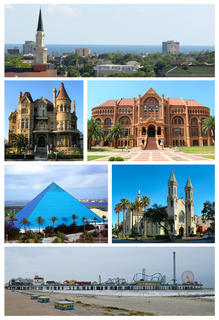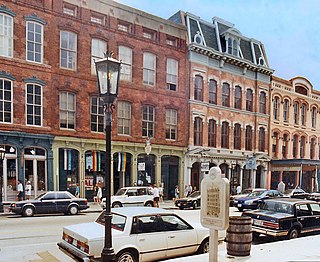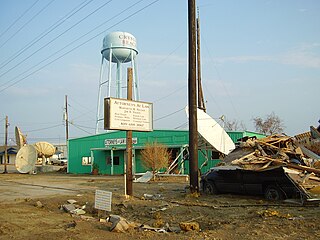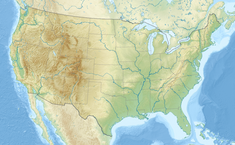
John Sealy Hospital is a hospital that is a part of the University of Texas Medical Branch complex in Galveston, Texas, United States.

Galveston is a coastal resort city and port off the Southeast Texas coast on Galveston Island and Pelican Island in the U.S. state of Texas. The community of 209.3 square miles (542 km2), with a population of 47,743 in 2010, is the county seat of surrounding Galveston County and second-largest municipality in the county. It is also within the Houston–The Woodlands–Sugar Land metropolitan area at its southern end on the northwestern coast of the Gulf of Mexico.

The University of Texas Medical Branch (UTMB) is a public academic health science center in Galveston, Texas. It is part of the University of Texas System. UTMB includes the oldest medical school in Texas, and has about 11,000 employees. In February 2019, it received an endowment of $560 million.

Port Bolivar is an unincorporated community located on the northern shore of the western tip of the Bolivar Peninsula, separated from Galveston Island by the entrance to Galveston Bay. The Bolivar Peninsula itself is a census-designated place, in Galveston County, Texas, and part of the Houston–Sugar Land–Baytown metropolitan area. The entire peninsula was severely damaged during Hurricane Ike on September 13, 2008; re-building efforts were still continuing as late as 2013.

The Strand Historic District, also known as the Strand District, in downtown Galveston, Texas (USA), is a National Historic Landmark District of mainly Victorian era buildings that now house restaurants, antique stores, and curio shops. The area is a major tourist attraction for the island city and also plays host to two very popular seasonal festivals. It is widely considered the island's shopping and entertainment center. The district includes properties along the south side of Harborside Drive and both sides of The Strand and Mechanic Street from 20th Street westward to 26th Street.

The Bishop's Palace, also known as Gresham's Castle, is an ornate 19,082 square feet (1,772.8 m2) Victorian-style house, located on Broadway and 14th Street in the East End Historic District of Galveston, Texas.

Nicholas Joseph Clayton was a prominent Victorian era architect in Galveston, Texas. Clayton constructed many grand religious and public buildings in Galveston including the First Presbyterian Church. He is also credited as the architect of Sacred Heart Catholic Church and of the Main Building of St. Edward's University in Austin, Texas. He also designed an addition to St. Mary Cathedral in Galveston. "His work represents a lifetime, worked out day by day under the most ordinary and circumstantial conditions, dedicated to the cause of architecture as the public art."

Crystal Beach is an Unincorporated community in the Bolivar Peninsula census-designated place, in Galveston County, Texas, United States. Also known as Patton, Crystal Beach stretches 7 miles (10 km) along Texas State Highway 87 in the middle of Bolivar Peninsula.
Moody National Bank (MNB) is a nationally chartered bank, founded in 1907, that is based in Galveston, Texas.

The Southgate–Lewis House is located one mile east of the Texas State Capital in Austin, Texas, at 1501 East 12th Street. The house was constructed in 1888 and now stands as an African-American Historical Landmark and as a repository for African-American History and Culture in a region of east Austin, which historically became an African-American neighborhood. The City of Austin has now declared this region to be "Austin's Black Cultural District." The Southgate-Lewis House is located in the center of the "African American Cultural Heritage District".
The Moody Foundation is a charitable foundation incorporated in Texas and based in the island city of Galveston. It was chartered in 1942 by William Lewis Moody Jr. and his wife Libbie Rice Shearn Moody "to benefit, in perpetuity, present and future generations of Texans." The Foundation focuses the majority of its funding on programs involving education, social services, children's needs, and community development.
William Lewis Moody Jr. was an American financier and entrepreneur from Galveston, Texas, who founded a private bank, an insurance company, and one of the largest charitable foundations in the United States. Moody was active in the day-to-day operations of his companies until two days before his death.

The United States Customs House and Court House, also known as Old Galveston Customhouse, in Galveston, Texas, is a former home of custom house, post office, and court facilities for the United States District Court for the Eastern District of Texas, and later for the United States District Court for the Southern District of Texas. Completed in 1861, the structure is now leased by the General Services Administration to the Galveston Historical Foundation. The courthouse function was replaced in 1937 by the Galveston United States Post Office and Courthouse.
Mary Elizabeth Moody Northen was an American financier and philanthropist from Galveston, Texas. She was the daughter of financial and insurance tycoon William Lewis Moody, Jr. and aunt of businessman Shearn Moody, Jr.

The History of Galveston, Texas, begins with the archaeological record of Native Americans who used the island. The first European settlements on the island were constructed around 1816. The Port of Galveston was established in 1825 by the Congress of Mexico following its successful revolution from Spain. The city served as the main port for the Texas Navy during the Texas Revolution. Galveston was founded in 1836 by Matthew Sabo and served as the capital of the Republic of Texas. The Battle of Galveston was fought in Galveston Bay during the American Civil War when Confederate forces under Major General John B. Magruder attacked and expelled occupying Union troops from the city.

The Samuel May Williams House is a former museum in Galveston, Texas. The second-oldest surviving residence in Galveston, it is now on the National Register of Historic Places. It was designated a Recorded Texas Historic Landmark in 1964.

The George Washington Grover House is a two-story house located at 1520 Market in the East End Historic District of Galveston, Texas. Built in 1859, the house is one of the oldest brick residences in the city.

The Isaac Heffron House is a two-story building located at 1509 Postoffice Street in the East End Historic District of Galveston, Texas. The house was built by Isaac Heffron, a prominent Galveston contractor in the Victorian period and during the city's recovery from the 1900 Galveston Hurricane. Later, the house was the residence of T.J. Holbrook, a Texas state senator from 1922 to 1939.

William Keiller was a Scottish born anatomist who trained in anatomy at the Edinburgh Extramural School of Medicine and was appointed as the first Professor of Anatomy at the University of Texas Medical Branch (UTMB) at Galveston, a post he held for 40 years. He served as Dean of the UTMB Medical School and as President of the Texas Medical Association. Many of his anatomical drawings and paintings are preserved and displayed at the Blocker History of Medicine collection at UTMB Moody Medical Library.




















